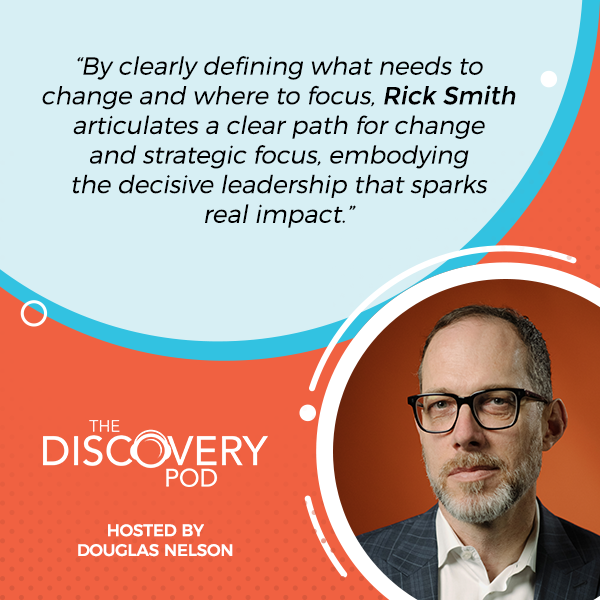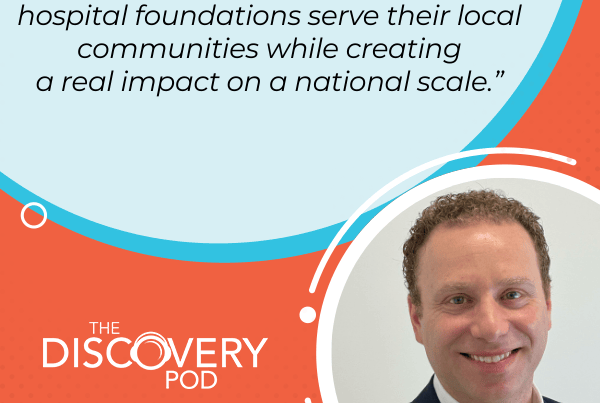
The Canadian Climate Institute is at the forefront of research and policy solutions for a sustainable future. In this episode, Douglas Nelson welcomes Rick Smith, President of the Canadian Climate Institute, for a compelling conversation on the future of climate policy in Canada. As a leading voice in environmental advocacy, Rick shares insights on the urgent actions needed to drive meaningful change, the role of innovation in sustainability, and how businesses and policymakers can collaborate for a greener future. Tune in and be part of a vital discussion that offers clarity and real-world solutions for one of our planet’s most pressing challenges.
—
Listen to the podcast here
Canadian Climate Institute With Rick Smith, President
Understanding The Canadian Climate Institute’s Mission
On this show, we have Rick Smith, the President of the Canadian Climate Institute, Canada’s leading climate change policy research organization. For more than twenty years, Rick has worked to protect people from the damaging impacts of pollution. He was previously the Executive Director of Environmental Defense Canada. He has a PhD in biology and is the executive producer of the 2024 documentary Plastic People.
In our conversation, Rick talks about how he and his colleagues are advocating major social change using data and data alone, the facts related to climate change, and communicating them to policymakers and Canadians right across the country. Rick is a compelling champion for the environment. He’s also a compelling leader in our social profit sector. There is a lot to learn from his approach to leadership and advocating for a cause that means so much. Please enjoy my conversation with Rick Smith.
‐‐‐
Welcome to the show, Rick.
Thanks so much. It’s good to be here.
As President of the Canadian Climate Institute, there are so many questions to ask you. There are so many positive stories and probably more to worry about than to feel positive about. I’m hoping you can start off telling our audience about the work of the Canadian Climate Institute and your role.
It’s a pleasure to be able to talk about this great organization that I’ve the pleasure to lead. The Canadian Climate Institute is the biggest climate research outfit in the country. We have staff from coast to coast. We were set up about a couple of years ago as an expert independent advisor to governments and decision-makers across the country who are wrestling with an often complicated climate change issue. We create good ideas. We engage in public discussion. We talk directly to elected leaders across the country, corporate leaders, and important stakeholders to try to create some social cohesion around what is often a fraught discussion.
We work on all aspects of climate change. We have a team focused on net-zero policy, so questions around how to decarbonize transportation, buildings, and heavy-emitting industries. We have a team focused on adaptation. We have a series of questions about how to keep Canadian communities safe from climate-driven flooding and wildfires.
We then have a team focused on clean growth. This is the economic question, the job creation question. As patriotic Canadians, how are we going to make sure that our country prospers through this transitional period? We work in both official languages. We work very closely with indigenous nations across the country. Our job is to try to be the people who keep the climate change discussion moving week in and week out.
That’s great. I certainly have been aware of the work that you do. One of the things that I’m curious about, given how you’re structured in that role of providing advice to governments of all levels, is how do you and your organization balance advocacy of, “These things must change,” with that advisory of, “Here are some things you could do.”
First and foremost, we’re a research organization, so we’re rooted in the numbers. We start from the premise or the scientific certainty that climate change is accelerating, but that there are solutions, and not just solutions in a general and ephemeral way, but certain policy decisions will lead to predictable outcomes, both in terms of emission reduction and enhanced competitiveness for the Canadian economy. A big part of what we try to do in the discussion and with governments across the country is to help with prioritization.
Climate change is an enormously complicated question. Carbon is emitted in a number of ways throughout our lives. There are many policy levers that can be pulled to reduce emissions. A lot of our reports revolve around suggested prioritization for Canadian governments, like, “Federal government, of the 5 dozen things you could do, here are the 3 things that you must do in order to achieve a semblance of climate progress.” One of our reports, for instance, came from our adaptation team. We had a whole series of priority recommendations for governments at all levels across the country as to how to keep Canadian communities safer from flooding and wildfires, these climate-driven extreme weather events.
It’s very easy to get depressed about the state of the planet, but there’s actually a lot of good things happening. Share on XAs a research organization, you’re making that information available and putting it in front of decision makers. How do you make them do it?
There are only so many ways to herd the cats. We can’t make anybody do anything. I am proud of the fact that a lot of our ideas and a lot of our research efforts have had a beneficial impact on the climate discussion across the country. One of the threads that’s woven through everything that we do is a solutions-focused. It’s very easy to get depressed about the state of the planet and, in some places, relative lack of progress in climate change, but there are a lot of good things happening when it comes to emissions reduction across the country. Part of what we try to do is highlight what’s working, and then work for a broader uptake of those solutions across provinces or across cities.
Balancing Climate Reality And Hope In Leadership
It’s an interesting challenge. We see it in a number of areas, like the social profit sector, housing, health, and social services, in particular, where there’s a strong need to make the case to show the evidence that the problem is real or worsening in those examples as in yours, but also needing to highlight that there is progress.
There’s something we can do. If governments act, if donors respond, and if we can align ourselves to move in a positive direction, good things can happen. How do you, on a personal level as the leader of your organization, balance the need to remind people, “This is a big, bad, scary thing that’s very real, but don’t lose hope. There are some positive things happening.” It can be a difficult balance to strike.
That’s right. We want to alert people to the challenge. We want to name the challenge. In our case, we quantify the challenge, but we also want to motivate people to look at solutions. You’re right. That’s not an easy thing to do some days. Part of our attitude is that history is not a foregone conclusion. It’s not like we don’t know what needs to be done here.

Canadian Climate Institute: We want to alert people to the challenge, but we also want to motivate people to look at solutions. History is not a foregone conclusion.
If you look at the build-out of clean electricity, the uptake of electric vehicles, and increasing heat pump penetration in housing across the country, there are any number of things that are going right in terms of the climate change discussion across the country, or at least things that are going right that are relevant to emission reduction that people might not even think about in a climate change context. At all times when I come to work, I feel very grateful to be working on climate change at this moment in time because I get to see it up close. I get to see all the victories, the big ones, and the little ones happening across Canada and around the world. That’s motivating for me and our staff.
The Resilience Of Decarbonization Amid Challenges
You had written in an op-ed in the Toronto Star in response to some of the changes that were happening in the United States with the new president. It was one of the best news stories that I’ve read in a while because you outlined the resiliency of this decarbonization change. Certainly, they can slow it down, but there’s a lot of momentum for the change that has already started. How do you characterize that change, that resiliency, or that robustness, and how do we keep it moving?
Clearly, what’s happening South of the border is craziness, and then you and I are sitting here talking for the next little while. I’m sure by the time this interview is over, the tariff situation will have flip-flopped five more times. We’ll have a whole bunch of catching up to do by the time this interview is over. I don’t want to diminish how wacky and how damaging the actions of the Trump administration are, but I do think that, at the moment anyway, because Trump is so dominant in the news cycle, there’s a tendency to overreact to what he’s able to do.
It’s true that Trump is not interested in climate change. He has said that “he hates windmills”. At times in the past, he said that he doesn’t like electric vehicles, but I noticed that he said that he’s going to buy a Tesla to support Elon Musk. I don’t know what to believe about that. Clearly, he’s unhelpful to the climate change discussion. However, my strong conviction and my submission to your audience is that he will be able to delay but not stop progress on climate for a few reasons.
First of all, the US, like Canada, states have substantial jurisdiction over matters that are relevant to climate change. States build electricity systems. States set regulations for cars. States set regulations for heavy-emitting industries. There are about 24 US states led by California and New York that have banded together to say, “We don’t care what Washington is doing. We are going to stay the course when it comes to ambitious climate change targets, building out clean electricity, and accelerating the uptake of electric vehicles.” That’s about 50% of the US market. To put that another way, Trump’s foot-dragging on climate change is only going to impede 50% of the US market.
I was in the UK. The UK remains steadfast in accelerating carbon dioxide emission reduction. Europe is accelerating. Our organization works directly with colleagues in all sorts of different countries around the world, South Africa, Chile, Colombia, and Brazil. In all of these places, the governments and the business communities understand that decarbonization is the name of the game and that electricity, batteries, and electric vehicles are the growth segments of their respective markets. With Trump, there will be a moment in time when he’s going to impede things a bit in the States, but there are a lot of drivers of climate change that are not going to shift.
This is the last thing I’ll mention here. We’ve done some polling on this. It wasn’t that long ago that most Canadians, most Americans, and most people around the world regarded climate change as something that their kids or their grandkids would have to worry about. All of a sudden, there’s extreme flooding and wildfires happening every spring and summer in every corner of the globe. More people recognize that climate change is an urgent and accelerating threat to their communities, their families, and themselves in the here and now. That’s a very different place for the climate change discussion to be versus a few years ago.
In our country, there’s a grim inevitability. Every spring and every summer, we know, unfortunately, that there is going to be flooding and wildfires somewhere in our country. Climate change has permanently moved from an environmental policy pigeonhole into a much more potent public policy pigeonhole with things like healthcare, crime, and things that affect people in the here and now, things that people can touch and understand as proximate threats to themselves and their families. That’s another reason why I think progress to clean up these clear problems with respect to climate change will only accelerate in the coming years.
That reminded me of a conversation I had with my thirteen-year-old son about a camping trip. We’re planning this summer to meet up with his cousins. He said, “When does the fire season start?” like it was a normal thing. It was chilling. He wasn’t being provocative. He was like, “Is there going to be smoke when we’re camping?” That was very real.
Staying Focused On Key Climate Action Levers
As you were talking, one of the things that is relevant for social profit leaders to take away from that is in describing what is going to continue despite what’s happening South of the border, you shared clear levers and forces related to your organization’s work. You’re like, “Here’s what we need to be focusing on. Here’s what we need to be changing.”
It takes not just message discipline in the form of communications, but planning and strategy discipline to be able to stay focused on those. What work have you and your colleagues done at the institute to make sure that you’re able to focus on those levers and forces of change that resonate or that you need to communicate?
That’s a big part of what we do. We do a lot of modeling and calculation of the impact of different policies. At the federal level, we’ve tried to be very specific about what the half dozen or so key policies are to reduce emissions across the country. As one example, there’s a lot of focus in Canada on the consumer carbon tax. I would say 90% of the climate change discussion in our country revolves around this one policy.
We did a study where we demonstrated that, at best, by 2030, the consumer carbon tax is responsible for about 10% of the solution. What a strange place to be in as a country that we’re spending the vast majority of our time in the climate change discussion focused on this one policy that is, I won’t say ineffective, but certainly not as effective as other policies that are far less contentious and receive far less attention.
Is that good news, that the things that are 90% of the solution are able to move forward while we stumble on these 10%?
It’s certainly a mismatch in the debate between the effective policies and the scrutiny that policies are getting. We’ve spent a lot of time thinking through how to improve industrial carbon pricing, for instance, which is what big industry pays, the system that affects only exporting industries. There’s no interface at all with Canadian consumers. That’s very important in terms of emissions reduction. As other major trading partners of ours are figuring out their own carbon trading systems, it is important that we have a system like that to stay competitive in terms of our trading partners.
We’ve done some work on methane regulations. Methane is the lesser-known cousin to carbon dioxide. , in terms of greenhouse gases. Methane is a very potent greenhouse gas. They’re mostly produced through leaks in industrial facilities. It’s quite easy to abate. You plug the holes. Methane regulation is incredibly important and far less contentious than I can go on. There’s a lot of room in terms of climate change policies to both reduce emissions and enhance the competitiveness of Canadian businesses.
One thing to point out is that electrification is increasingly the name of the game. Batteries are increasingly the name of the game in terms of commodity vehicles around the world. Some of our competitors, like China, are deadly serious about owning the world supply of critical minerals, battery supply chains, and electric vehicle manufacturing. It is very important that Canada compete and win in that arena.
Overcoming Barriers To Climate Action Progress
You mentioned at the outset that you feel fortunate to have the role you do, being able to do this work, share these messages, and do this research. We know what needs to be done. You’ve said it three times in our conversation. It’s not like we need to figure out an answer. How do you stay optimistic? How do you keep the energy going? We know the answer, we know it’s important, and we’re running into these barriers to get moving on it. What do you think about those barriers?
People who care about climate change have to keep two ideas in their heads at the same time. Number one, we’re not doing enough, and we need to accelerate progress. The evidence of harm from climate change is clearer than ever. The other thought is that we’ve gotten a lot better at reducing emissions, and we need to accelerate that progress. It’s the optimistic thought or the hopeful thought and the challenging thought. I try to do that every day. I try to keep those two thoughts in my head at the same time. At the same time, as I’m impatient for progress, I’m ambitious for progress. There are good things happening that we need to spread around.
People who care about climate change have to keep in mind that we’re not doing enough and need to accelerate progress, but also that we’ve gotten a lot better at reducing emissions and need to accelerate that progress. Share on XI have a couple of quick examples. The generation of electricity in Canada, by and large, is a success story. About 85% of the electricity that we generate in Canada is generated through non-emitting, non-polluting means, such as hydropower, nuclear, wind, and solar. As a consequence, you see a significant investment from vehicle manufacturers and battery manufacturers coming into Canada because those companies want a guarantee of clean electricity for their industrial processes.
Also, as a consequence of this move towards electricity globally, there are big opportunities for Canadian liners. Some of your readers, I’m sure, have heard about this debate around critical minerals, which is a category of minerals necessary for batteries. Canada has a lot of critical minerals if we can get our act together to accelerate those mines.
If we look at a provincial level, so much of the climate change debate in Canada is focused on the federal level. It’s important to point out that provinces have significant powers, and there are lots of interesting things happening at the provincial level and things going right. Quebec, for instance, moved forward a building decarbonization law that will start in a more methodical, widespread way to transition Quebec buildings from fossil fuel heating to non-emitting electric heating.
A big reason to do this is not just to bring emissions down, but because in most places in this country, heat pumps and electricity as a building heating source are cheaper for consumers than the fossil fuel alternative. For a lot of these non-emitting machines, such as heat pumps and electric vehicles, they’re not only good for emission reduction, but they’re better news for consumers. They’re more affordable alternatives. These are some of the successes that we try to hold up and encourage a more widespread adoption.

Canadian Climate Institute: Celebrate the victories, but be honest about the challenges when they arise.
The wheel is turning in the right direction.
We’ve got to turn a little bit more quickly.
Encouraging Climate Awareness And Public Engagement
We’ve had the opportunity to work with a number of environmental organizations through our work here at The Discovery Group. That balance between communicating the crisis that has arrived and saying, “Here’s something positive to do about it,” whether it’s the Pacific Salmon Foundation looking at restoring habitat and talking about what habitat and adaptation looks like. Their community of supporters is with them to hear that story.
What we hear a lot from our environmental clients is that we need more people to listen. What prevents people from listening to not just the obvious research about climate change, but the progress that you’ve been describing through our conversation? For someone who’s in this and cares about this, it seems willful sometimes that people aren’t willing to listen. It’s intentional to build those bricks in their ears. From your perspective, you must have these conversations all day, every day. What is standing in the way of people accepting that message?
I’ve been working on this issue for a while. There’s been a huge shift in the public appetite for change. I remember when I first started working in environmental policy many years ago. The discussion wasn’t nearly as mainstream as it is now, and it was far more theoretical, wonky, and disconnected from people’s daily lives.
We know this as consumers, parents, and family members. Everybody’s busy. Everybody’s got to get the kids to soccer. You’ve got to pay the mortgage or the rent on time. My family’s day was completely derailed because my wife was out getting groceries and the muffler fell off the car in the parking lot, so she had to drive to the garage with no muffler.
My point here is that we’re all busy. We’re all trying to do the best for our families. Our days get derailed by unpredictable things, and we have to cope with them. Meanwhile, organizations like mine are out there saying, “In amongst your muffler falling off and getting the kids to soccer, can you please think about climate change?” That’s a winning argument on some days and not on others, and that’s okay.
One thing that we need to do better as advocates in this space is to more directly connect the climate change discussion with people’s quality of life. We’re making some progress, but we have ways to go. For heat pumps, for instance, which are non-polluting sources of building heating and air conditioning, we need to make the case that heat pumps are better machines. They work better, they’re cheaper, and they’re going to improve your quality of life.
That’s the best argument for a heat pump as opposed to some more theoretical, altruistic argument about the benefits of heat pumps when it comes to emission reduction. We’ve learned some lessons, but as climate change advocates, we need to better connect what we’re talking about to what people care about, which is what’s going to make their life better and what’s going to make their community safer. We have those answers, but we need to articulate them in a more direct way.
When you're working on climate change, there are really serious challenges every day. Share on XI imagine that there are alternatives to point to that can improve people’s quality of life. It makes that conversation a little bit more straightforward.
That’s right. Things have changed quickly. I work in this area. A couple of years ago, our furnace was malfunctioning, so we had to think about the heating and cooling in our old house in Toronto. It was the HVAC guy who talked me into a heat pump. I had no idea. I was like, “There’s this machine that’s got a remote, and you can turn it up and down? It heats and cools, and is cheaper? That’s amazing.” This was only a few years ago. Meanwhile, the price of electric vehicles is going down. The price of wind, solar, and electricity production declines every year. It’s the best deal going. Technology is on our side. The technology and the costs of these technologies make the argument for us.
Keeping Teams Motivated For Climate Solutions
As you’re describing this, you’re giving a lot of reasons for optimism. You’re connected to the research that leads to this optimism. As a leader of your organization, how do you keep your team focused on that positive outcome? I asked you earlier about how you do it yourself, but how do you keep those around you motivated to be spreading the good news?
You celebrate the victories. You’re honest about the challenges when they arise. We have a particular organizational challenge that never goes away, which is that we’re a virtual organization. Everybody works from home. Even people who work in the same city work from home right across the country. On balance, that’s helpful to us because we’re able to hire smart, dedicated people from wherever they are in the country. We’ve got some incredible staff working in quite remote parts of the country that if we had offices, we never would’ve hired them otherwise.
The challenge with a virtual organization is that there’s no such thing as bumping into each other by the water cooler or hanging out together in the lunchroom. Every organizational decision, every interaction with a coworker, and every problem-solving meeting needs to be planned and needs to be scheduled. When you’re working in climate change and there are serious challenges every day, and to be honest, there are terrible things happening somewhere in the world, somehow having a virtual organization, having to plan out every encounter, and having to proactively reach out to your coworkers has an advantage there, given that we’re working on climate change and every conversation has to be carefully thought through. You’re helping me think through my organizational dynamics here. I appreciate that.

Canadian Climate Institute: Across the political spectrum, very interesting discussions are starting about the future of our country. It’s important that we think beyond the chaos.
Looking Ahead: Future Hopes For Climate Action
There is a powerful insight there. In our group, we have folks in five different provinces. We’re keeping everybody on the same page. We have scheduled check-ins. There are deliberate conversations. I’m someone who I still very much miss being able to pop into somebody’s doorway and have a quick conversation. We’re not going to get everybody from across the country to move to Vancouver, so we’ve been learning. As we come to the end of our conversation, I get to ask my favorite question. I’ve been looking forward to your answer to this. What are you looking forward to?
I’ve been excited by this renewed sense of Canadian patriotism across the country and the possibilities that it opens up. There is a very short period of time in response to this external threat from the South. There’s been this rejuvenation of patriotism and a moment when maybe new thinking is possible with respect to how we structure our country in the future. I’m looking forward to that discussion.
As you and I are having this discussion, it’s an absolutely ridiculous news day in terms of flip-flopping a terrorist from the US, and the DAO and NASDAQ are tanking. It’s a crazy day in the news. One of the outcomes of this that has been quite positive for our country is across the political spectrum and the difficult geography of our country, there are very interesting discussions starting about what the future of our country looks like, how we can put our economy onto a different kind of footing, what the roles of different provinces are in this. It’s important through that discussion that we think beyond the chaos of Donald Trump. Think medium-long-term and, to use a Canadian expression, make sure that we’re skating to where the puck is going economically. I’m looking forward to this discussion.
That’s great. On behalf of the newly and still united Canadians, I wanted to thank you very much for your work and the work of your colleagues. It’s very important and meaningful. I appreciate you taking the time to be on the show.
This was a real pleasure. It was good to meet you.




